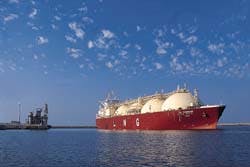LNG fleet increases in size and capabilities
Henry J. Linser Jr., Michael J. Drudy, Fred Endrizzi, Anthony A. Urbanelli
Mobil Shipping & Transportation
Fairfax, Va.
The LNG tanker Al Zubarah loads at Ras Laffan (Fig. 1; photo by Charles Crowell, 1996).The LNG fleet as of early 1997 consisted of 99 vessels with total cargo capacity of 10.7 million cu m, equivalent to approximately 4.5 million tons. 1
One of the newest additions to the fleet, the 137,000-cu m tanker Al Zubarah (Fig. 1), is five times the size of the original commercial vessel Methane Princess. Al Zubarah's first loading of more than 60,000 tons occurred in December 1996 for delivery to Japanese buyers from the newly commissioned Qatargas LNG plant at Ras Laffan.
That size cargo contains enough clean-burning energy to heat 60,000 homes in Japan for 1 month. Measuring nearly 1,000 ft long, the tanker is among the largest in the industry fleet and joined 70 other vessels of more than 100,000 cu m. Most LNG tankers built since 1975 have been larger-capacity vessels (Fig. 2 [28645 bytes]).
LNG shipping requirements
As much as the LNG business has grown over the years, a seven-fold increase from 10 million tons in 1975 to 73 million tons in 1995,2 the associated shipping requirements over this period have increased even more, from 16 billion to 170 billion ton-miles-more than a ten-fold gain (Fig. 3 [25645 bytes]).
The reason is that average shipping distances have been increasing as the LNG business has expanded over a wider geographical matrix.
The industry today consists of nine importing countries, Japan being the largest at more than 45 million tons, and nine exporting countries, Indonesia at more than 25 million tons being the largest producer and Qatar the newest among LNG-exporting nations ( Table 1 [29023 bytes]). At present, there are 12 loading ports and 27 receiving terminals.
The original voyage of Methane Princess from Algeria to England covered 1,500 nautical miles; the distance from Indonesia to Japan, the largest current trade route, is about 3,000 miles; the voyage for the newest project from Qatar to Japan is 6,400 miles-nearly double that of Indonesia.
As new capacity is added in the future from the Middle East, Africa, Australia, and other locations for supply to traditional as well as new market destinations, the likelihood is that average ton-mile movements will continue to increase proportionately more than overall volume growth.
Statistics through 1995 show that the LNG shipping industry logged more than 1,400 ship-years (cumulative total of ship operational years), more than 23,000 voyages, and 770 million tons of delivered cargo without an accident involving breach of the cargo tanks or loss of life (Table 2 [24567 bytes]).4
Only six serious incidents have been recorded in more than 30 years during commercial operations: two groundings, one collision, and one mechanical breakdown, none with cargo leaks. Two cargo-handling leaks in port were handled without serious consequence.5 6
It is the best safety record in the maritime industry and reflects attention to safety in all aspects from containment system and vessel design and construction to maintenance, crewing, and other operational standards and procedures.
Containment systems; vessel design
All LNG vessels are doublehull design which provides protective spacing between the ship's outer hull and cargo tanks to reduce the risk of cargo breach in the event of grounding or collision.
All systems transport LNG at -163° C. (-261° F.) and at atmospheric pressure. The low temperature and liquid state is maintained by the insulation of the cargo tanks and evaporation of the methane.
The pressure is kept close to atmospheric by drawing off the evaporated gas and burning it as fuel. Although several variations exist in tank design, the containment systems fall into two main categories, membrane and independent (Fig. 4 [47470 bytes]).
Membrane tanks use the inner-hull structure as an integral part of the cargo tank. The tank consists of a thin stainless or high nickel-steel primary barrier backed by a secondary barrier supported by rigid, load-bearing insulation.7
The loads of the cargo and tanks are transferred directly to the hull structure, and the tanks are constructed in-place on the vessel.
Independent tanks are self-supporting and are not part of the ship's hull. Non-load bearing insulation is applied to the external surface of the tank.
By the nature of their designs, materials, and analysis techniques, only a partial secondary barrier is required. Independent tanks are generally built in whole or part in specialized facilities and are installed or assembled within the vessel. The most recognizable, perhaps, are the spherical tanks seen on many ships.
In recent years a new self-supporting containment system of nonspherical configuration has been developed. Known as prismatic, it has been incorporated in two recent LNG newbuilding vessels.8 Both systems use tanks constructed of aluminum.
The main LNG containment systems that are actively marketed today by their developers include the following:
- Two membrane systems licensed by Gaz Transport S.A., Trappes, France. (A new design is under development incorporating the best elements of each system.)
- Two independent tank types: the spherical system licensed by Kvaerner Moss, Oslo, and prismatic tanks licensed by Ishikawajima-Harima Heavy Industries Co. Ltd., Tokyo.
These proven systems reflect an ongoing process of improvements and refinements by all of the companies.
While the relative advantages of today's membrane vs. independent containment systems are often subject to debate, the fact is that each type has been proven to be reliable and competitive.
This is evident from the composition of the fleet in which there are almost an equal number of each type in operation-40 membrane, 52 independent (50 spherical, 2 prismatic), and 7 of various earlier designs.9
Of 19 new vessels under construction or on order, the split is 8 membrane and 11 independent (Table 3 [40433 bytes]).
Propulsion
Typically, somewhere between 0.1% and 0.2% of the cargo capacity of the ship evaporates every day, depending on the effectiveness of the cargo tank insulation, the environmental conditions, the ship's motions, among other factors.
This provides about 50% of the energy requirement of the boilers, with heavy fuel oil providing the balance.
In some cases, LNG is purposely evaporated to provide ship's fuel, depending on the relative value of the LNG and bunker fuel, and other factors.
In addition, during regular steady state operations, the vessels also retain a "heel" of 1-3% of the cargo, depending on the ballast voyage length and ship operating parameters to cool the tanks in preparation for the next loading (Fig. 5).
As a means of disposing of boiloff gas as fuel, LNG carriers continue to use steam-turbine propulsion systems. On-board reliquefaction of the boil-off gas has not yet proven economically feasible.
Dual-fuel (heavy fuel oil and gas) marine diesel engines are in development but none is yet in service. Although steam-turbine systems are less fuel efficient than the diesel engines used for most new merchant ships built today, they are long-lasting with relatively lower maintenance costs.
Compared to their oil and LPG tanker counterparts, LNG vessels are designed and built to operate at faster speeds. This reflects mainly their relatively higher capital and operating costs and corresponding need to maximize the annual amount of cargo delivered per vessel.
Typical speed range for LNG vessels is 17-20 knots compared to 14-16 knots for most other tankers.
For perspective as to size, a 135,000-cu m LNG ship is approximately the same length and width as a 150,000-dwt ton crude tanker but carries less than half the weight of cargo because of differences in the relative densities of crude and LNG (Table 4 [34542 bytes]).
Construction
Many of the design parameters of LNG carriers are dictated by the International Code for the Construction and Equipment of Ships Carrying Liquefied Gases in Bulk (the IGC Code), published by the International Maritime Organization, a UN agency.
The IGC Code specifies the materials of construction, the location of cargo tanks, and machinery, piping, boil-off, and cargo-handling requirements, among many other factors.
The IGC code is administered by classification agencies which typically act on behalf of the country in which the ship is registered.
Construction of LNG carriers is more labor-intensive and requires more engineering than oil tankers. Special equipment and a highly skilled labor force are required for construction of the containment systems which must be licensed.
All of the containment systems mentioned earlier are supported by their developers via license agreements with multiple shipyards, with some yards holding licenses for more than one system.
LNG vessels require about 36 months to build from contract award to delivery vs. 18-24 months for most conventional tankers.
Quality control requirements are perhaps the most stringent and demanding within the merchant shipbuilding industry. While these factors limit the number of shipyards able to build LNG vessels, they help ensure that stringent standards are maintained.
At present, there are fourteen shipyards active or experienced in building LNG vessels, one in the U.S., four in Europe, five in Japan, and four in Korea.
Another four shipyards hold containment-system license agreements (Table 5 [61370 bytes]).
Although many of the earliest LNG ships were built in the U.S., none has been constructed here since 1980. Japanese and European yards have built most of the vessels delivered over the past decade, with Korea becoming a recent major entrant.
Having delivered their first LNG tanker in 1994, Korean yards currently have six ships on order with additional orders anticipated soon. Another ten vessels are under construction or on order from Japanese yards, and three at European yards.10
Overall, estimated industry shipbuilding capacity is about 20 large LNG tankers per year. Available capacity, in fact, depends upon price and competing demand for other types of vessels built by the same yards such as conventional oil tankers, container ships, and cruise ships.
The price today for a new 135,000-cu m LNG tanker is greater than $200 million/vessel. This price is subject to, as are other commercial vessel types, market forces and cost factors.
In the future, it is not unreasonable to expect that another 50 to 70 new LNG vessels will be required over the next decade to support the significant growth in LNG demand that is anticipated.
This requirement is well within the range of current shipbuilding capacity. The timing of project orders and demand for other ship types, however, are factors that will affect availability and market price at any given point in time.
Operations, maintenance
Mandatory certification of the officers and crew is required in all aspects of LNG vessel operations including cargo hazards and transfer procedures and full understanding of safety and emergency procedures.
Personnel involved in LNG vessel operations are among the most experienced of any segment in the shipping industry, reflecting relatively low personnel turnover levels.
Port and terminal operations also entail special procedures to enhance safety. Daylight passage only is followed at many of the LNG ports as well as use of extra escort tugs and pilots.3
In some cases, ports are closed to other ships during LNG vessel transits. Berthing and unberthing criteria are well established and followed at all locations. These criteria are limits on vessel berthing imposed by such environmental conditions as wind, current, and tide.
Maintenance is of high priority not only for safety and reliability but also as a matter of good economics, given the high cost of building new vessels and lack of replacement alternatives.
The cargo itself and associated containment systems are noncorrosive. With good maintenance of the hull, machinery, and auxiliaries, LNG vessels are capable of long operating lives.
Actual experience has now clearly demonstrated useful service lives well in excess of the 20 years originally assumed for many projects.
Indeed, several vessels built in the 1970s, following close technical evaluation, have already seen their employment contracts extended well into the next century.11
Commercial structure
LNG projects in general are characterized by large capital costs, relatively long lead times, and contracts between seller and buyer of 20 or more years.8
LNG vessels are integral in such arrangements, representing 20-40% of total capital requirements, depending on voyage distances and associated numbers of vessels required.
As such, the vessels are mainly dedicated for specific sales contracts and associated fixed routes. Ship size and shore tankage are usually optimized as an integrated system.
Fewer, larger ships offer lower total capital and operating costs. Size is usually limited, however, by port and terminal restrictions which has been a factor in the evolution of the fleet to a current maximum vessel capacity below 140,000 cu m.
Ownership and control of the vessels varies from project to project. In some cases, the shipping is the responsibility of the buyer; for others, the seller.
The vessels may be owned by the project or the buying entities, or chartered from independent ship owners or a ship-owning consortium.
As the industry has grown and gained a proven track record, ownership and control have become much more diversified, with each arrangement essentially customized to the project. This arrangement reflects decisions based on several financial and commercial factors as well as long-term relationships.
Unlike the oil and most other bulk-shipping segments, there is virtually no spot charter market (single-voyage hire) for LNG ships by virtue of the technical and commercial structure of the business.
A short-term charter trade, however, has been developing in recent years involving vessels previously involved with long-term projects and temporarily available until new longer term employment arrangements commence.
The number of such short-term movements increased from 9 voyages in 1990 to a high of 75 trips in 1994 and a somewhat lower 55 trips in 1995 (Table 6 [52670 bytes]).4
The cargoes fulfill a need for seasonal and peak-shaving requirements and in some cases for phase-in of new capacity until delivery of newbuilding vessels.
Such requirements will increase in the future as the overall LNG industry continues to expand, but it remains to be seen how many vessels may be available short-term for such employment.
Interestingly, several short-term movements have involved passage through the Suez Canal (35 trips in 19954) moving LNG supplies from the Middle East and Far East to Europe and the United States.
Suez Canal authorities are quite comfortable in handling the passage of LNG ships from a safety, technical, and commercial standpoint and support the growth of such shipments. As the LNG business continues to grow and evolve, there may indeed be greater cross-linkage between eastern and western supplies and markets via the canal.
The future: larger vessels?
Unlike the early development of LNG carrier technology, future technical developments will most likely be more evolutionary than revolutionary.
For example, development of a radical new cargo-containment system is unlikely because of the high initial costs of design and approvals.
The high reliability demanded of LNG carriers necessitates that changes be undertaken slowly and only with the highest confidence of success. This cautious approach protects the outstanding safety record of LNG carriers and does not mean a lack of innovation to improve on cost and performance.
Among possible developments could be the construction of larger vessels. Designs for LNG carriers of up to 200,000 cu m have been offered by various shipyards, and there remains no technical reason holding back further growth in LNG carrier size.
Recognizing that existing ports and terminals may be unable to accommodate larger vessels because of draft, mooring limits, or port authority regulations, perhaps the most likely application for larger vessels will be in the development of new markets.
The economies of scale of larger LNG carriers are there to be captured, and the institutional limits in these trades are not yet in place. Of course, the larger vessels would be limited to these specific markets, and this must be balanced with the potential economic benefits.
The propulsion system of LNG carriers may well see a change from steam turbines to dual-fuel diesels. Dual-fuel diesels are in use in nonmarine applications, and significant development work for a marine application has been under way for several years.
Practical, reliable solutions for providing the high-pressure gas injection required for dual-fuel diesels are being sought, as well as means of reducing the pressure requirements.
LNG ship owners will continue to solicit proposals for alternative propulsion and boil-off handling systems in their ordering programs and a change is likely at some point.
As part of the potential change in propulsion systems, improvements in cargo tank insulation effectiveness may also develop.
In the design of the LNG ship, there is a trade-off between the cost of incremental insulation and the value assigned to reducing the quantity of boil-off gas. Use of a more efficient power plant may justify a further reduction in the daily boil-off rate.
References
1. "The Liquid Gas Carrier Register," Clarkson Research Studies, 1996. 2. "LNG-Evolution and Development," Petroleum Economist Ltd., 1996. 3. "Information for LNG Export and Import Terminals," Sigtto. 4. "LNG Log 21," William duBarry Thomas, Sigtto, 1996. 5. "Liquefied Gas Ship Safety, Analysis of the Record, 1964 to 1981," Poten & Partners Inc., New York, 1982. 6. "Shipping Incident Report 1982-1995," Sigtto. 7. Liquefied Gas Handling Principles, 2nd edition, McGuire and White, Sigtto, 1996. 8. Tusiani, M.D., The Petroleum Shipping Industry, 1996. 9. "LNG in World Markets," Poten & Partners Inc., New York, 1996. 10. "World Shipyard Monitor," Clarkson Research Studies. 11. Peile, C.H., and Eddy, R.G., "Reducing LNG Transportation Costs," Second Doha Conference on Natural Gas.The Authors
Henry J. Linser Jr. is manager of fleet planning, industry analysis and LNG, for Mobil Shipping & Transportation Co., Fairfax, Va. Since joining Mobil in 1970, he has held several positions in supply and distribution, Middle East, technical services, and marine transportation.Linser holds a BS (1968) in chemical engineering from Rensselaer Polytechnic Institute.
Michael J. Drudy is the senior planning analyst in the fleet planning, industry analysis, and LNG department of Mobil Shipping & Transportation Co. He holds a BS in accounting and an MBA in finance, both from St. Johns University.
Fred Endrizzi has been employed by Mobil for 35 years. His undergraduate degree is in naval architecture and marine engineering from Webb Institute.
Anthony A. Urbanel is manager for marine services for the technical division of Mobil Shipping & Transportation Co. He holds a BS in naval architecture and marine engineering from Webb Institute, an MBA from New York University in international business and finance, and is a member of the Society of Navel Architects & Marine Engineers.
Copyright 1997 Oil & Gas Journal. All Rights Reserved.





